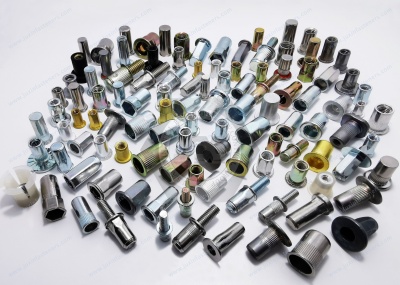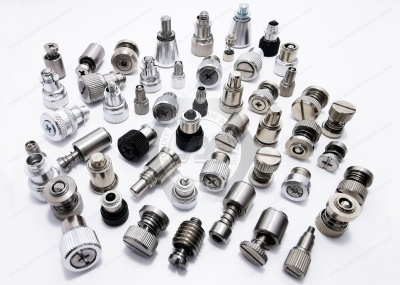Call Us
+86 136 6007 9809
Call Us
+86 136 6007 9809
Jan. 13, 2024
Application of riveting technology in the cabinet of urban rail converter
No pollution is about health, so environmental protection and lightweight design are inevitable trends. At the same time, the user's demand for beauty is increasing. They not only focus on the essential functions of the product but are also increasingly concerned about the quality of the product's appearance. The appearance of the quality of the product is related to the overall grade of the upgrade.
As a core component of rail vehicle equipment converter, the cabinet of the traditional production process uses 3mm and the following stainless steel plate assembly welding. It becomes stainless steel density and cabinet weight. In addition, the connection between the components using welding, the cabinet inside a large number of welding nuts, welding stud structure, in the welding process and after cooling, uneven temperature field so that the plate to produce welding stress, welding deformation, these difficult to accurately level the welding deformation seriously affect the appearance of the product quality. Achieving lightweight will require the use of lightweight materials to replace stainless steel. Aluminum alloy density is small, has high strength, good impact resistance, and corrosion resistance, and is the ideal lightweight alternative material. At present, the connection process of aluminum alloy has welding, riveting, and so on. However, aluminum alloy welding is prone to porosity, biting edges, cracks, unfused, unwelded, and many other defects. Welded joints soften seriously, and welding deformation is significant; these defects will cause local stress concentration, seriously affecting welded joints' fatigue strength.
Riveting relative to welding, small deformation, no grinding, green, low operating environment requirements, and stable and reliable strength of the connection can be applied to the complex structure of the connection between the various metals, especially suitable for the connection between the thin plate. Riveting can meet the needs of aluminum alloy connections, and it has a better quality and longer service life.
Mil. Spec. Aluminum Low-Profile Domed Head Solid Rivets: Made of heat-treated aluminum, these rivets meet MIL-C-5541. They are lightweight, nonmagnetic, and chemically treated for good corrosion resistance, leaving a gold-colored finish. A lower head height than standard domed head rivets provides a more finished appearance.
Installation of solid rivets requires access to both sides of the material, a hammer, or a reliable rivet tool. To achieve the most consistent results and a professional appearance, we recommend using a riveting air hammer, a rivet setter that matches the rivet's head style, and a bucking bar.
Aluminum Twist-Resistant Rivet Nuts: These rivet nuts are one-third the weight of steel rivet nuts and are mildly corrosion-resistant. A ribbed body holds the nut in place, so it won't turn when tightening a screw. Also known as blind inserts, they can be installed when you can access only one side of the material. Install in a drilled hole using a rivet nut tool. The tool collapses the nut, creating a backside flange that holds the nut to the material. Length is measured from under the flange. Installed length is the maximum length of the barrel when installed.
Aluminum Wide-Thickness-Range Domed Head Blind Rivets: Lightweight and nonmagnetic, these rivets have good corrosion resistance. They grip a much more comprehensive range of material thicknesses than standard blind rivets. Use to join material when you only have access to one side. The low-profile domed head creates a finished appearance.
The combined thickness of the material must fall within the rivet's material thickness range. Shear strength is the force it takes to break a rivet from the side, and tensile strength is the pull a rivet can withstand without breaking. Joint strength is also affected by rivet spacing and hole size.
Rivets with aluminum mandrels have more excellent corrosion resistance than rivets with steel mandrels.
Installation requires a blind rivet tool (sold separately) with a nosepiece that matches the rivet's diameter.


Performance solutions for riveting applications:Riveting involves pull riveting and compression riveting. Both require different installation spaces and equipment and are used on other occasions.
1. Blind riveting: riveting is in the riveting process, riveted parts in the external tension, plastic deformation occurs, relying on the deformation part of the clamping substrate to achieve a reliable connection, the central core rivets, ring groove rivets, riveting nuts, and other connection methods.
2. Blind rivets are a class of single-sided connections with rivets, using special rivet guns for riveting. When riveted, the rivet core is pulled by the unique rivet gun so that the rivet body expansion plays the role of riveting. These rivets are particularly suitable for single-sided operation of the occasion, as well as templates, signs, door sealing frames, covers, and other riveting.
3. The Ring groove rivets are used for structural connections between the nail body and the ring. Riveting, the first nail body is inserted into the hole of the connected parts, and then from the other side of the corresponding parts of the ring on the nail body, and then with a unique ring groove rivet gun head on the tail of the nail body, and against the ring end face, press the trigger, the rivet gun will be squeezed into the nail body groove so that the ring and the nail body to form a 100% combination of the ring and the nail body to produce a permanent tightening force, to riveted fastened to the connecting parts and used for cabinet side panels, top panels, and other frames and lugs riveted.
4. Rivet nut is a form of riveting that can realize the two functions of riveting and nut connection; there are flat head, small head, countersunk head, hexagonal, half-hexagonal and other types, divided into through-hole or not through-hole; single-sided riveting, reliable assembly, no deformation of the base material, alternative to welded nuts used in thin plate structure to avoid deformation of the thin plate welding. It is worth mentioning that the hexagonal rivet nut is widely used because of its good anti-rotation function.
Rivet nut materials are mainly carbon steel, stainless steel, aluminum alloy, etc.. Carbon steel material rivet nuts are all high-quality carbon steel 08F with Fe/Ep—Zn5.c 2C protective layer on the surface. See our specification sheet for details. When riveting nuts need to use special riveting tools, relying on the rivet gun screw rotation pull the rivet nut so that longitudinal compression occurs at the end of the thin-walled area of the raised deformation, clamping the riveted parts to achieve riveted connections.
4.1. The main principle of rivet nut selection is based on the head shape, thread specifications, plate thickness, mechanical properties, and other aspects of the comprehensive selection.
4.2. Flat-head hexagonal rivet nuts have the best anti-rotation function; riveting after quality problems emerge is not convenient to rework.
4.3 Countersunk head rivet nuts: There is a need for riveted parts to process countersunk holes, adding one more process.
4.4. Through-hole rivet nuts have the function of waterproof sealing characteristics.
5. Pressure riveting: pressure riveting is the riveting process under external pressure, pressure riveting parts so that the base material undergoes plastic deformation, the base material is squeezed into the nut (column) anti-tension grooves and anti-rotation grooves so that the nut (column) can prevent the rotation and anti-pulling, to achieve a reliable connection, the central pressure riveting studs, pressure riveting nuts. This type of connection requires the strength of the riveted part to be greater than the strength of the base material; copper alloy, aluminum alloy, ordinary carbon steel, and other plates are suitable for pressure riveting nut (column) crimping; stainless steel plate is not suitable for pressure riveting nut (column).
Comparison of cabinet appearance quality:Welding requires heat input, uneven cooling will cause deformation of the parts, and welding operation requires high skills of workers. The cabinet will produce welding slag and spatter when welding, which needs to be polished. The surface is often uneven and has grinding marks. The products with riveted joints have no welding points, no need for grinding, and the surface quality is consistent. The use of riveting nuts, riveting nuts instead of welding nuts, no deformation of the workpiece, the aesthetics visible, while riveting to solve the welding method is not easy to achieve on the dissimilar materials (such as aluminum and steel, metal and non-metal connections). Hence, the riveting process of the appearance of the product quality is higher than that of welding.
Riveting technology in converter cabinets:Alstom, Bombardier, and other companies manufacturing urban rail products widely use riveting technology. Our high-voltage box products are riveted with core-pulling rivets on the top panel skin, ring-groove rivets are used to rivet the module mounting bracket in the next-generation high-frequency auxiliary transformer, and hexagonal rivet nuts are used in the main transformer of the railroad transit. All these products have passed the relevant tests, accumulating successful experience in applying riveted joints.
Juxin Fasteners' new quadruple next-generation inverter and auxiliary inverter cabinet adopts aluminum alloy riveted structure, with the reinforcing beams between the frames and the door buckles connected with ring-groove rivets, and the door frame edges connected with core-pulling rivets; the rectangular plug, top cover plate, MVB cover plate mounting parts are connected with hexagonal rivet nuts; and the internal cable tie rods, cable tie rows, and device boards of the cabinet are mounted with pressure rivet nuts (pillars): pressure rivet nut (post), ring groove rivet connection. The weight of the stainless steel welded auxiliary converter cabinet is 265kg. In Comparison, the new next-generation platform additional converter cabinet with aluminum alloy riveting technology weighs 200kg, a weight reduction of 24.5%, with an apparent lightweight effect. At the same time, the new next-generation platform auxiliary converter cabinet has no welding deformation, and the cabinet is flat and beautiful, which ensures the assembly precision of the devices; the rectangular plug, top cover plate, MVB cover plate adopt flat-head hexagonal rivet nuts to solve the problem of sealing strip escaping and over-compression caused by bolt fastening, which ensures the quality of the products. Cabinet internal tie rods, tie rows, device board mounting parts using rivet nut (post), and ring groove rivets are connected to effectively reduce the cabinet weld seam and ensure the cabinet side plate is flat.
Through the strength test to verify the feasibility and superiority of the riveting process in the cabinet body application, in full compliance with the design requirements, for the application of subsequent projects to provide a reference. Adopting aluminum alloy riveting technology and urban rail converter cabinets to achieve lightweight requirements, the appearance of the quality is a significant improvement for the aluminum alloy cabinet riveting to lay the foundation. Through the implementation of the project, the use of pull riveting and pressure riveting technology in the production of urban rail converter cabinets will effectively improve production efficiency and product quality, improve the working environment, and reduce production costs; riveting technology will undoubtedly be widely used in the subsequent cabinet design and production.
If you are looking for high-quality 18-8 Stainless Steel Wide-Thickness-Range Flush-Mount High-Strength Blind Rivets fasteners or technical support for structural design, welcome to contact me. Thanks.Email:adelajonly@gmail.com
Website: https://www.juxinfasteners.com
Contact Us
Tel.:
+86 020 8621 0320
+86 020 3121 6067
Technical Support:
Navigation
SEND INQUIREY